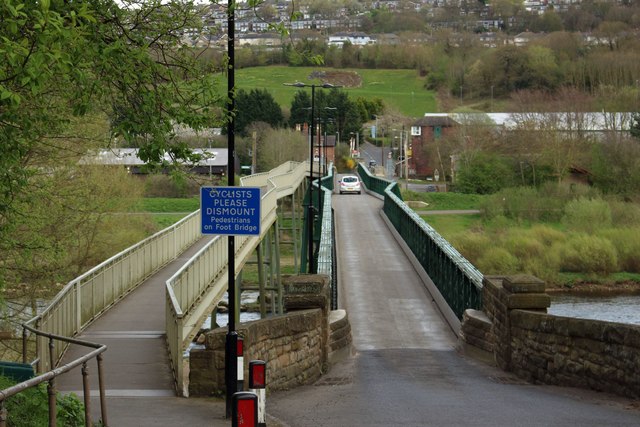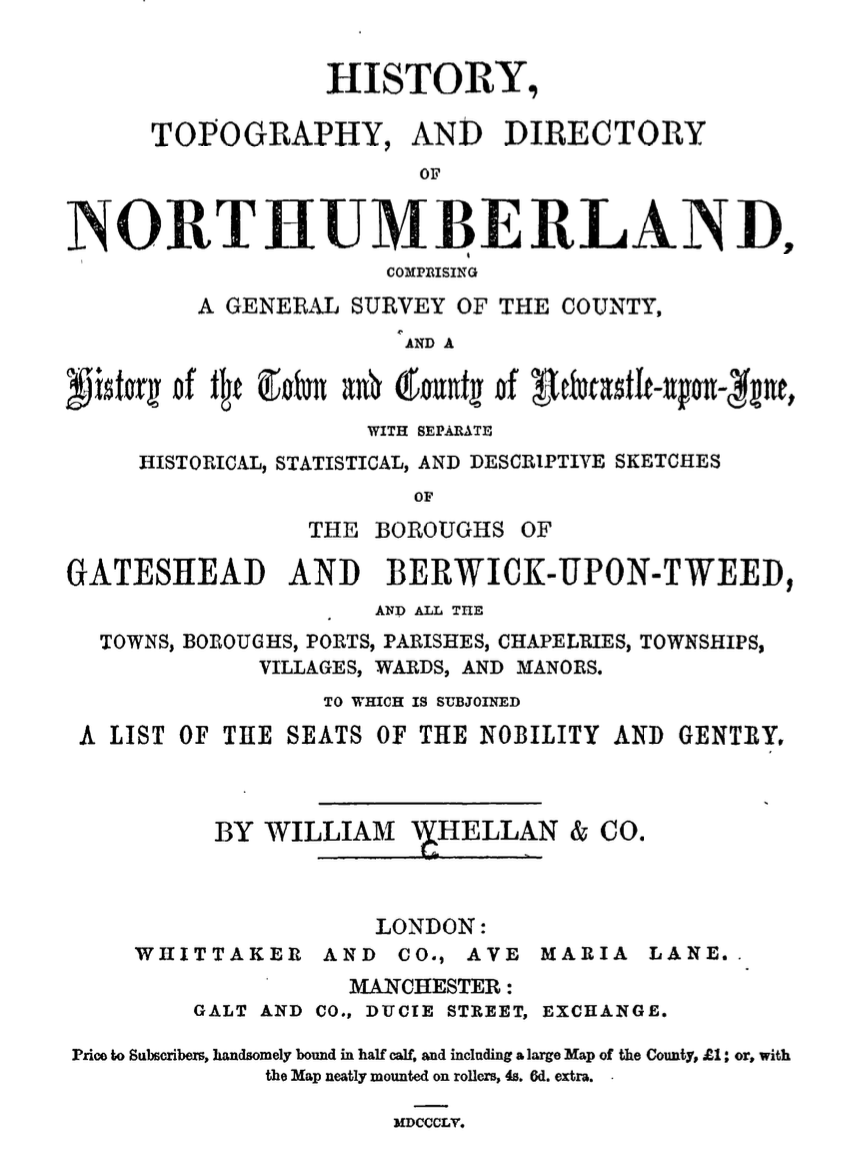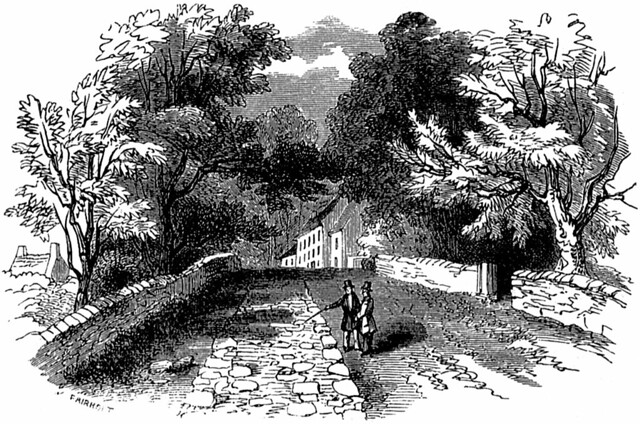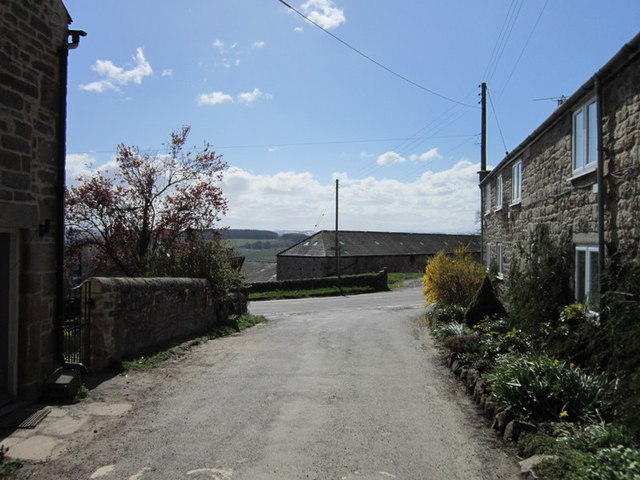Topics > Northumberland > Ovingham > Ovingham Parish, 1855
Ovingham Parish, 1855
Extract from: History, Topography, and Directory of Northumberland...Whellan, William, & Co, 1855.
OVINGHAM PARISH
OVINGHAM is a parish, comprising the townships of Dukeshagg, Eltrlngham, Harlow-hill, Hedley, Hedley-Woodside, Horsley, Mickley, Nafferton, Ovingham, Ovington, Prudhoe, Prudhoe Castle, Rouchester, Spittle, Welton, Whittle, and Wylam. It is bounded by the parishes of Stamfordham, Heddon-on-the-Wall, and Bywell St. Andrew and St. Peter, except on the south-east, where it is separated from the county of Durham by the Stanley and Milkhouse Burns. It is about seven miles in length by five in breadth, and comprises an area of 15,740 acres. Its population in 1801, was 2,628; in 1811, 2,810; in 1821, 2,742; in 1831, 3,019; in 1841, 3,418; and in 1851, 3,962 souls. This parish is intersected by the river Tyne, and is beautifully diversified by gentle elevations.
DUKESHAGG, or DUKER'S HAGG, a township in this parish, situated two miles and three-quarters S.S.E. of Ovingham, is the property of the Duke of Northumberland, who is also lord of the manor. It contains 1,323 acres, and the rateable value is £60. The number of its inhabitants in 1801, was in 1811, 7; in 1821, 9; in 1831, 8; in 1841, 7; and in 1851, 7 souls. This township consists of one farm which is occupied by Mr. John Dodd.
ELTRINGHAM is a township and hamlet, the property of Anthony Humble, Esq. The township comprises an area of 320 acres, and its rateable value is £730, including £50 tithes. Population in 1801, 24; in 1811, 39; in 1821, 52; in 1831, 50; in 1841, 87; and in 1851, 119 souls. Here is a large number of coke ovens, which afford employment to many persons, and are carried on by Messrs. Cuthbert and Cookson. There is a salmon fishery on the river Tyne here, of which Mr. Thomas Cooke, who keeps a respectable inn at the ferry, is lessee. THE HAMLET of Eltringham is situated one mile S.S.W. of Ovingham.
DIRECTORY. Thomas Cook, vict. Eltringham Boat House Inn; and Anthony and Thomas Humble, brick manufacturers.
HARLOW HILL, a township and village in Ovingham parish, is the property of the Duke of Northumberland, who is also lord of the manor. The area of the township is 993 acres, its rateable value £1,316 8s. and the number of its inhabitants in 1801, was 115; in 1811, 121; in 1821, 124; in 1831,149; in 1841, 137; and in 1851, 148 souls. THE VILLAGE of Harlow Hill occupies an elevated position on the road leading from Newcastle to Carlisle, ten and a half miles from the former place. It consists of four or five farm houses, a few workshops, a public house and several cottages.
DIRECTORY. Ann Davison, shopkeeper; John Hall, blacksmith and agricultural implement maker; Thomas Hindmarsh, publican; William Robson, cartwright, joiner, and farmer; Joseph Thompson, shopkeeper; and the farmers are Anthony Bell, James Bell, and Robert Elliott, Stankwell.
HEDLEY-ON-THE-HILL is a township and village in this parish, containing 1,399 acres, the rateable value of which is £900 10s. The population in 1801, was 166; in 1811, 172; in 1821, 168; in 1831, 193; in 1841, 229; and in 1851, 219 souls. The Duke of Northumberland and A. Surtees, Esq., are the owners of the soil and lords of the manor. In this township is a coal mine which produces coal of a superior quality, and is entered by a horizontal or water level drift. Ironstone of excellent quality is also obtained here. THE VILLAGE of Hedley-on-the-Hill is situated at the south-west extremity of the parish, three miles south of Ovingham. It consists of five farm houses, a respectable inn, a few good grocers' shops, four workshops, and a number of cottages, which are chiefly inhabited by agricultural labourers, pitmen, and others. Here is a small Wesleyan Methodist Chapel, which was erected by subscription, in 1837. The Primitive Methodists meet for worship in a private house. HEDLEY SCHOOL was built by subscription, in 1848. It is self-supporting, and is conducted by Mr. Andrew Hindmarsh.
|
Newton William, woodkeeper, Hedley Spring House Snowball John, innkeeper Walker William, coal owner
Blacksmiths Jackson Ralph Stokoe Parmella
Boot and Shoemakers Dodd Andrew Dodd William
Cartwrights Buckam John Robs on George, and joiner
Farmers Harrison John, Hedley Park Harrison Joseph |
Johnson John Phillipson J. Richardson William, Airey Hill Snowball John Snowball William, Hedley Grange Scott George Swinburn William Walker William, & coal owner White Thomas, Hedley West Riding
Grocers & Dealers in Sundries Bowman Mary Dodd F. & Son Little Archibald Oxley Joseph Swinburn Thomas
Tailor and Draper Corn John |
CARRIER to Newcastle, Archibald Little, on Saturdays.
HEDLEY WOODSIDE is a township, situated three miles south of Ovingham. It contains 1,364 acres, and its population in 1801, was 88; in 1811, 76; in 1821, 55; in 1831, 60; in 1841, 73; and in 1851, 86 souls. The rateable value is £493. This township consists of four farms, the property of the Duke of Newcastle, and A, Surtees, Esq. The farmers are George Browell, Hedley Woodhead; John Dixon, Broad Oak and Hollins; and Thomas Willey, Hind's Wood.
HORSLEY is a township and village, the property of the Duke of Northumberland, Edward James, Esq., John Dobson, Esq., J. H. Hind, Esq., and others. The township comprises an area of 1,4 78 acres, and its rateable value is £1,766. The number of inhabitants in 1801, was 200; in 1811, 262; in 1821, 257; in 1831, 293; in 1841, 286; and in 1851, 314 souls. THE VILLAGE of Horsley is situated on the road leading from Heddon-on-the-Wall, to Hexham, one mile and a quarter north by east of Ovingham. It consists of some respectable farm-houses, two grocers' shops, two good inns, several workshops, and a number of cottages, occupied by agricultural labourers and others. Here is an Independent Chapel, a plain stone edifice, which was enlarged in 1729, and will accommodate about 300 persons. Rev. John Rain, minister. The Wesleyan Methodists meet for worship in the house of Mr. Archbold, in the room where the Rev. John Wesley often preached. The desk he then used is still there, and is preserved in memory of him who made use of it.
POST OFFICE, HORSLEY, Robert Hutchinson, postmaster. Letters arrive from Wylam at 2-15 p.m., and are despatched thereto at 2-45 p.m.
|
Brown Ann, grocer and dealer in sundries Common William, joiner and cartwright ( Rntter and Common); ho. Dunslow, Holm Gaddes Andrew, tailor Leightley John, brick maker Rain Rev. John (Independent) Rutter William, joiner and cartwright (Rutter and Common); ho. Horsley
Blacksmiths and Agricultural Implement Makers Redhead George, sen. Redhead George, jun.
Boot and Shoemakers Charlton George Hutchinson Robert Johnson John
Cabinetmakers Archbold William, and joiner and winnowing machine maker Rutter and Common, and joiners and cartwrights |
Farmers Arch bold William Bell William Fairbairn John, Horsley High Barns Hindmarsh Thomas Laws John, The South Bank Laws Robert, Easter Hopside Mordue John Nesbit William
Inns Crown and Anchor, Thomas Bum Lion and Lamb, Thomas Lathaen
Winnowing Machine Manufacturer Archbold William |
MICKLEY is a township and village, in the above parish, containing 1,188 acres, the property of W. B. Wrightson, Esq., Joseph John Humble, Esq., of Prudhoe House, Mr. John Newton, of Mickley, and others. The rateable value of the township is £2,042, the tithes £208, and the gross estimated rental, £2,485. Population in 1801, 186; in 1811, 181 ; in 1821, 178; in 1831, 211; in 1841, 297; and in 1851, 566 souls. Each landowner is lord of the manor of his own property, with the exception of the manorial rights of the common, which was enclosed about forty years ago, by the owners of the contiguous estates, in proportion to the quantity they were owners of. The manorial rights of what was formely the common, belong to the above named W. B. Wrightson, Esq., M.P., by whom a school was erected, in 1821, and Hall Yard Chapel in 1823. MICKLEY BANK colliery, in this township, is worked by Mrs. Bewick, of Cherry Burn. Here are also some coke ovens. THE VILLAGE of Mickley is situated one mile and a half south by west of Ovingham, and consists of a few respectable farm -houses, with a number of cottages. HALL YARD is an adjoining hamlet to Mickley. Here is a Chapel of Ease to Ovingham, erected in 1823, by W. B. Wrightson, Esq.; it will accommodate about 120 persons.
MICKLEY SQUARE, a village in this township, consists of five rows of double cottages, a good grocer's shop, with one or two small ones. The population now numbers 500, and the inhabitants are principally employed at Mickley Colliery, and the coke ovens in the township of Eltringham.
MOUNT PLEASANT is a hamlet in Mickley township, consisting of two rows of cottages, which are tenanted by workmen employed at the colliery and coke ovens.
CHERRY BURN in this township, is the birth place of the late Mr. Thomas Bewick, the celebrated wood engraver, for a sketch of whose life see Newcastle. It is now the residence of .Mrs. Elizabeth Bewick, coal owner, &c.
|
Bates Thomas, under-ground agent, Mickley-square Davison Thomas, innkeeper, Mount Pleasant Eltringham Edward, cartwright Lowes Joseph, blacksmith Lyon William, Esq. surgeon, Riding House Rippon John, joiner Sempster Thomas, schoolmaster and beerhouse keeper Thompson William, colliery engineer, Mickley-square Thompson William, superintendent of coke ovens, Mickley-square Todd Horatia Wellington, resident viewer, Mickley Colliery; ho. Mount Pleasant Young William, innkeeper
Boot and Shoemakers Phillipson John Phillipson William, Mount Pleasant Young William |
Farmers Bewick Mrs. Elizabeth, and coal owner, Cherry Burn Browell William, Mickley Dixon Willy, Mickley Grange Lishman John and Thomas Lumley John Newton John, and yeoman, Mickley Richardson John, Mickley Moor Young Thomas, and wood keeper, Mickley Bank
Grocers Drowell George Clark John, Mickley-square Little Samuel, and draper, Mickley-square Rutherford Thomas, & plate layer, Mickley Taylor Mary, Mount Pleasant
Tailors Henderson Joseph, Mickley Potts James, Mickley-square |
NAFFERTON is a township and hamlet, the property of W. B. Beaumont, Esq., M.P. It contains 773 acres of land, and its rateable value is £500. Population in 1801, 41 ; in 1811, 34; in 1821, 39; in 1831, 60; in 1841, 35; and in 1851, 37 souls. THE HAMLET of Nafferton is situated in a pleasant vale, about two miles north-west by north of Ovingham. Here are the remains of an ancient building, supposed to have been a religious house. This township consists of one farm, in the occupancy of Mark Spraggon, farmer.
OVINGHAM is a township and village, in the parish of the same name, the property of the Duke of Northumberland, Colonel Bigge, Mr. George Bedlington, and George Hutchinson, Esq. The township comprises an area of 523 acres, and its rateable value is £770. The number of its inhabitants in 1801, was 253; in 1811, 243; in 1821, 265; in 1831, 233; in 1841, 257; and in 1851, 330 souls. The Duke of Northumberland is lord of the manor, and holds his manorial courts in the village, on the Tuesday in Easter week.
THE VILLAGE of Ovingham occupies an agreeable situation on the north bank of the river Tyne, nine miles east of Hexham, and eleven miles west of Newcastle. It possesses a copious supply of excellent water, from Jordan's Well, at the east end of the village, besides an additional supply for common use, conveyed through pipes from a reservoir, about a quarter of a mile north of Ovingham. This latter was given by the Whittle Dean Water Company, as a compensation for the water taken by the company from the stream, which forms the boundary between the townships of Ovingham and Ovington. The village contains two respectable inns, a bleach works, several workshops, and a number of cottages. Here was formerly a Cell of Black Canons, subordinate to the priory of Hexham. It was founded by one of the Umfraville family, and at the time of the Dissolution, was valued at £12 2s. 8d. per annum. The estate of this house, with its appropriated tithes and the advowson of Ovingham, with a fine glebe, came into the possession of the Addisons, and was their seat for a long period. THE CHURCH, dedicated to St. Mary the Virgin, is an ancient structure, consisting of nave, aisles, transepts, and chancel with a square tower containing three bells. This edifice exhibits three distinct specimens of architecture, the tower being Saxon, the door-way Norman, and the body of the church early English. The living, a vicarage in the archdeaconry of Northumberland, and deanery of Corbridge, is valued in the Liber Regis at £5 8s. 4d., returned at £85. gross income, £158. Tithes commuted in 1839; aggregate amount £77 15s. Patron, Colonel Bigge ; vicar, the Rev. George Bigge, M.A. The parish register commences in 1679. An addition of about a quarter of an acre has been made to the grave-yard in which the church stands, on account of the increasing population of the parish. OVINGHAM SCHOOL is erected upon what was unenclosed ground, the property of the Duke of Northumberland, and attached to it is a dwelling house, with a small garden for the teacher.
There is a lodge of Oddfellows, called " The Loyal Lord Prudhoe Lodge," held at the Ovingham Inn, and the “Ovingham Friendly Society,'' is also held at the same house ; Mr. James Weatherley is secretary for both societies. Ovingham bad formerly a royal· charter for a weekly market, and was governed by a bailiff; two annual fairs are still held here on April 26th and October 26th.
CHARITIES. This parish possesses four benefactions for the use of the poor, viz. :- £2 per annum, bequeathed by Edward Fletcher, in 1699, to be distributed yearly on March 1st and June 13th; £6 a year, left by John Blackett, in 1707, which was to be distributed by the minister and church- wardens on All Saints Day ; £2 10s., bequeathed by Anthony Surtees, in 1725, to be given annually to the aged poor, men and women, and fatherless children of the parish; and a rent charge of four guineas a year, given to the poor, aged, infirm, and religious persons of Ovingham parish.
POST OFFICE, OVINGHAM, William Easterby, postmaster. Letters arrive, from Newcastle and Gateshead, at 11-30 a.m. and are despatched thereto at 8-15 p.m.
|
Miscellany Armstrong Robert, stonemason and ornamental stone cutter, Bridge End Inn Bedlington George, brewer, &c. Bedlington John, gardener Bedlington Mrs. Mary, Brick House BRITiSH ECONOMICAL MANURE COMPANY, John Weatherley, agent Davison David, assistant manager, Ovingham Bleach Works Dawson Joseph, quill and pen manufacturer Dobson Mr. George, fanner, Mount Huley Henderson George, grocer and farmer Hutchinson George, Esq, surgeon Jobnson William, farmer, Chapel Farm ROYAL LORD PRUDHOE LODGE OF ODDFELLOWS, Ovingham Inn, James Weatherley, secretary Makepeace John, schoolmaster OVINGHAM FRIENDLY SOCIETY, James Weatherley, secretary OVINGHAM PARISH ASSOCIATION, for the prosecution of Felons, John Weatherley, secretary OVINGHAM WATER PANTS, John Weatherley, secretary and treasurer Robson Jarnes, cooper |
ROYAL FARMERS' GENERAL FIRE, LIFE, AND HAIL-STORM INSTITUTION, John Weatherley, agent Shields Rev, T. W., M.A. Viearage Tate James, yarn merchant and agent, Ovingham Bleach Works Wilson John, blacksmith
Boot and Shoemakers Dawson John Easterby William
Grocers Henderson George, and fanner Lamb James Robson Mary
Inns Ovingham Inn, John Weatherley Ovingham Bridge End Inn, Robert Armstrong
Tailors Cook Martin, merchant tailor, Bleach Green Fletcher George Turner William Waugh Joseph |
OVINGTON is a township and village, the property of Henry Hind, Esq., Robert Surtees, Esq., Colonel Bigge, John Dobson Esq., and others. It contains 1,105 acres, and the rateable value is £1,763, with £164 tithes. Its population in 1801, was 344 ; in 1811, 369; in 1821, 362; in 1831, 331; in 1841, 380; and in 1851, 405 souls. The manorial rights are vested in the several proprietors. THE VILLAGE of Ovington occupies an elevated and healthy situation on the north bank of the Tyne, one mile W.N.W. of Ovingham. It consists of two respectable residences, two good inns, a few grocers' shops, and several houses and cottages. Here is an extensive brewery, belonging to Forster, Potts, & Co. OVINGTON SCHOOL was erected by subscription in 1843, and enlarged in 1850 by private donations. It is self-supporting, but under government inspection, and conducted on the national system, James Landell and Elizabeth Dunn, teachers. OVINGTON COTTAGE, the residence of Henry Hind, Esq., is a handsome modern erection.
|
Cook Martin, merchant tailor, Bleach Green Dunn Elizabeth, schoolmistress, Ovington School Errington John, blacksmith Finlay Thomas, tailor Hall Thomas Young, Ovingham Bleach Works Hedley George, butcher Henderson Robert, mason Henderson Thomas, mason Hind Henry, Esq. Ovington Cottage Jordan William, parish clerk Landells Jas. schoolmaster, Ovington School
Boot and Shoemakers Forster Thomas Harle George Henderson John Lawson William
Brewers Potts, Forster, & Co. Ovington Brewery |
Farmers Emmerson Thomas Hewison William Hunter George Potts Forster, and brewer, Ovington Hall Reed Thomas
Grocers Bell Elizabeth Dunn William, and provision dealer Surtees Mary
Inns Highlander, Walter Smith Ship, Luke Johnson
Joiners and Cabinet Makers Dunn William, and grocer Johnson Isac, and cartwright, &c. Proud Robert
Timber Merchant Johnson Isaac, & cartwright and joiner |
PRUDHOE is a township and village containing 144 acres, the principal proprietors of which are the Duke of Northumberland, the Rev. Robert Capper, Mr. Anthony Bell, John Swinburne, Esq., and Joseph John Humble, Esq., of Prudhoe House. These several landowners also exercise the manorial rights and privileges. The number of inhabitants in 1801 was 318 ; in 1811, 294; in 1821, 293; in 1831, 341; in 1841, 369; and in 1851, 386 souls. Rateable value £1,216 10s. THE VILLAGE of Prudhoe is pleasantly situated on a declivity south of the river Tyne, one mile S.S.E. of Ovingham. It consists of four farm houses, two inns, several workshops, and a considerable number of cottages. Here is a Wesleyan Methodist Chapel, which was erected by subscription in 1794, on land given by the late Anthony Humble, Esq., of this place. The Humbles are a very ancient family, and have been located in this place for upwards of seven centuries. PRUDHOE SCHOOL was erected by subscription in 1825, and is self-supporting. Mr. William Johnson, of Prudhoe Old Hall, has extensive fire-brick works in this township.
POST OFFICE, PRUDHOE.-Michael Hall, postmaster. Letters arrive, from Gateshead, at 10-45-a.m., and are despatched thereto at 8-8 p.m.
|
Baty Isaac, saddler Bell The Misses Hannah and Mary Humble John Joseph, Esq.,Prudhoe House Reed Robert, schoolmaster Rowe John, gardener Urwin John, cartwright Wright Thomas, joiner and cabinet maker
Blacksmiths Donkin Thomas Robinson William, and agricultural implement maker
Boot and Shoemakers Atkinson Robert Hall Michael Tulip John
Builder and Contractor Lishman John William Lishmant manager
Butchers Green William Jewett Charles |
Farmers Donkin John Jewett Jonathan Johnson William, Old Hall Lishman John Murray Joseph Riston John
Fire-Brick Manufacturer Johnson William, Prudhoe Old Hall
Grocers Hunter George, and registrar of births and deaths, &c. Jamison Thos. & wootlman
Inns Barley Mow, William Alther Doctor Syntax, William Shaw
Tailor and Draper Robinson Thomas
Woodmen Jamison Thomas Robson George Taylor John |
PRUDHOE CASTLE is a township and hamlet, the property of the Duke of Northumberland, who is also lord of the manor. The township comprises an area of 719 acres, and its rateable value is £829 1s. Population in 1801, 62; in 1811, 70; in 1821, 79; in 1831, 71; in 1841, 126; and in 1851, 102 souls. The Newcastle and Carlisle Railway intersects this township, and there is a station south of Ovingham. PRUDHOE CASTLE, from which the township derives its name, is situated on an eminence near the Tyne, and was anciently the principal seat of the Umfravilles, who were descended from Robert de Umfraville, lord of Tours and Vian, kinsman of William the Conqueror, from whom he had a grant of the valley, forest, and lordship of Reedsdale. The castle was gallantly and successfully defended against William, King of Scotland, in the reign of Henry II. Gilbert Umfraville, one of this family, is styled a " famous baron, guardian, and chief flower of the north." From this family, Prudhoe Castle descended to the Tailbois, who forfeited their estate at the battle of Hexham, in 1464. The King granted it to John, Duke of Bedford, and afterwards to Henry Percy, first Earl of Northumberland, in whose family it still continues. In the year 1529 the castle is described as ruinous. The outer walls appear to be the oldest part of the structure, as the square towers in the western side of the walls have circular basements, and the covered way which leads to the inner gate, is found to be of much stronger and better masonry than the lower part of the gatehouse tower itself. The keep has had winding galleries gained out of the thickness of the walls, and was three storeys in height. The ground on which the castle stands is high towards the river, and, on the opposite side, the walls have been defended by deep ditches, which were crossed by a draw-bridge. The remains of the castle have been secured from entirely falling, by judicious repairs in the parts most dilapidated.
The steep promontory upon which the old fortress stands, communicates with the adjoining grounds by a narrow neck of land, stretching towards the south, and is guarded by an outward wall on the north, built on the edge of the cliffs, which rise to the height of sixty feet above the level of the river. This ruined structure forms a conspicuous object in this part of the vale of Tyne, and from whatever point it is viewed, its great extent, broken walls, and crumbling ruins, produce an august appearance. THE HAMLET of Prudhoe Castle is situated half a mile S.S E. of Ovingham.
DIRECTORY. Joseph Bell, farmer, Broom Houses; John Charlton, Edgewell House; John Johnson, vict., Ovingharn Boat House Inn; Mrs. Sarah Laws, Prudhoe Castle; Messrs. George and P. S. Laws, Prudhoe Castle ; and John Reay, station master, Prudhoe Station.
ROUCHESTER, OR RUDCHESTER, is a township in this parish, situated three miles N .N. E. of Ovingham. It contains 644 acres of land, and its population in 1801, was 28; in 1811, 27; in 1821, 31; in 1831, 28; in 1841, 51; and in 1851, 48 souls. Thomas James, Esq., of Rotterburn Tower is landowner. This township contains the site of the Roman station Vindobala for a description of which, see page 29, and comprises but one farm, which is occupied by the landowner. Here is also a large freestone quarry. Alexander Scott, land steward, is the principal resident
SPITTLE is a township, two and a quarter miles north of Ovingham. It is the property of Robert Ormston, of Newcastle; contains 82 acres, and the number of its inhabitants in 1801, was 9; in 1811, 6; in 1821, 3; in 1831, 7; in 1841, 10; and in 1851, 10 souls. The rateable value is £70. It contains only one farm, which is in the occupation of Harrison Green, farmer.
WELTON is a township and hamlet, the property of W. B. Beaumont, Esq., who is also lord of the manor. The township comprises an area. of 1,183 acres, 42 of which are covered by the reservoirs of the Whittle Dean Water Works, and its rateable value is £1,070. Population in 1801, 90 ; in 1811, 77; in 1821, 67; in 1831, 60; in 1841, 59; and in 1851, 71 souls. The water works, which are partly in this township, and partly in that of Harlow Hill, consist of seven reservoirs, which cover an area of more than 100 acres, and.are capable of containing 330,000,000 gallons of water. The works were commenced in 1816, and completed in 1818. In 1850, a small supplemental reservoir was formed, and two years subsequently another large one, caned the "Great Northern," which covers an area of 40 acres. At the works there is a handsome and substantial stone cottage, having a spacious octagonal room, in which the Directors of the Water Works Company meet occasionally, the other apartments are occupied by the superintendent. THE HAMLET of Welton stands upon the line of Hadrian's vallum, three miles north by west of Ovingham, and according to Camden was the royal villa of King Oswy, which Bede calls Ad Murum, where Peada and Sjgebert, kings of the Mercians and East Saxons were baptised by Finan, Bishop of Lindisfarne. WELTON TOWER, which was long the seat of a family that bore the local name, is now in rums.
DIRECTORY. Charles Dobson, shoemaker ; George Johnson, Locker Hall; William Reed, superintendent, Water Works; and the farmers are George Byerley, Welton Hall; Charles Charlton, Welton High Town; and John Charlton, Welton New House.
WHITTLE is a township in this parish, situated one mile and a quarter north by west of Ovingham. It is the property of the Commissioners of Greenwich Hospital, contains 276 acres, and its rateable value is £420 10s. Population in 1801, 31; in 1811, 31; in 1821, 32; in 1831,20; in 1841,31; and in 1851, 23 souls. There is a corn mill in this township, worked by John Crozier and Brothers. Whittle Dean is a deep wooded dell, which gives name to the water works described in the township of Welton.
DIRECTORY. John Crozier and Brothers, corn millers, Whittle Mill ; and John Robson Spraggon, farmer, Whittle.
WYLAM is a township and village, the property of J. B. Blackett, Esq., Mrs. Bewick, Thomas H. Liddell, Esq., and others. J. B. Blackett, Esq. is lord of the manor. The township comprises an area of 930 acres, and its rateable value is £3,163 12s. Population in 1801, 673; in 1811, 795; in 1821, 728; in 1831, 887; in 1841, 984; and in 1851,1,091 souls. This manor was formerly the property of Tynemouth Priory, and at the Dissolution was granted by the Crown to a branch of the Fenwick family. It was transferred to the Blacketts in 1679, and has since continued their property. THE VILLAGE of Wylam is situated two miles east by north of Ovingham, and is very irregularly built ; the inhabitants are chiefly employed in the coal and iron works. There are a few good inns, and some well supplied grocers' and other shops. The river Tyne, at this place, is crossed by a wooden bridge, supported by stone pillars, and on the frame work is laid a single line of rails, communicating with the Newcastle and Carlisle Railway, the colliery, and the iron works. It belongs to a joint-stock company, who exact a toll of one penny from each passenger, every time he crosses the bridge. There is a Chapel here belonging to the Wesleyan Methodists.
POST OFFICE, WYLAM, Ann Davison, Postmistress. Letters arrive from Newcastle and Gateshead, at about eleven o'clock a.m., and are despatched thereto 4-46 p.m.
|
Atkinson G. C. Esq., Wylam Hall Atkinson J. J. surgeon Bell and Brothers, iron merchants, &c. Clementson _, Oakwood Hall Carvings George, blacksmith Davison John, gardener Davison Mary, spirit dealer Futers Alice, schoolmistress Harle William, under viewer Hunter Matthew, tailor James Edward, Esq.,Hollin Hall Moore John, colliery agent Mowbray Anthony, colliery engineer Potts Stephen, butcher Ramsay Robert, market gardener Rule George, schoolmaster Wylam Colliery. J. F. B. Blackett, Esq. Owner Wylam Railway Station William Bell, station master
Boot and Shoemakers Bone Edward Futers John
Corn Millers Brown Ann & Co., Wylam Mill, Edward Milburn, manager; John Burn, book-keeper |
Farmers Charleton William, and grocer, &c. Birid Inn Laws William, Warsh House March Robert, Wylam Wood Tate James, and yarn merchant ; ho. Ovingham Bleach Works
Grocers and Provision Dealers Charlton William, and farmer, Bird Inn Davison Ann, and draper, Post Office Marshall Richard, and draper
Inns and Taverns Bird Inn, John Charlton, and grocer, &c. Black Bull, William March, and butcher East Boat, John Greener Fox & Hounds, John Pringle Ship, Mary Mitchelson Three Tuns, George Greener
Beer House Watt James
|











